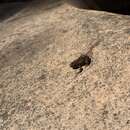en
names in breadcrumbs


Crinia riparia és una espècie de granota de la família Myobatrachidae que viu a Austràlia. El rang d'aquest endèmic d'Austràlia es limita a una petita àrea de la serralada Flinders al centre d'Austràlia del Sud. S'ha registrat a 200-600m des del nivell del mar. L'extensió de la presència de l'espècie és d'aproximadament 56.000km2. Aquesta espècie es troba per sota dels còdols i pedres a les vores de rierols pedregosos. Les cries es posen sota les roques a la vora dels rierols. Els capgrossos s'adapten als rierols de corrent ràpid. Pel que sembla, es reprodueixen a la primavera. No hi ha amenaces significatives per a la supervivència d'aquesta espècie. L'espècie es troba en Flinders Ranges National Park.[1]
Crinia riparia és una espècie de granota de la família Myobatrachidae que viu a Austràlia. El rang d'aquest endèmic d'Austràlia es limita a una petita àrea de la serralada Flinders al centre d'Austràlia del Sud. S'ha registrat a 200-600m des del nivell del mar. L'extensió de la presència de l'espècie és d'aproximadament 56.000km2. Aquesta espècie es troba per sota dels còdols i pedres a les vores de rierols pedregosos. Les cries es posen sota les roques a la vora dels rierols. Els capgrossos s'adapten als rierols de corrent ràpid. Pel que sembla, es reprodueixen a la primavera. No hi ha amenaces significatives per a la supervivència d'aquesta espècie. L'espècie es troba en Flinders Ranges National Park.
The streambank froglet or Flinders Ranges froglet (Crinia riparia) is a small, locally common, Australian ground-dwelling frog, of the family Myobatrachidae.
The streambank froglet is a small frog (2.5 centimetres measured from snout to posterior). The colouring can be red, brown, tan, to drab olive green colour with many shades in between. Like its relatives Crinia signifera, this frog is of extremely variable markings, with great variety usually found within confined populations. The dorsal and ventral surfaces are very variable. The dorsal surface may be smooth or warty. The tympanum of this frog is not visible. The colour under the throat is pale grey, the ventral surface backwards from the front legs is white with granular, mottled black.
The streambank froglet is found only in the area around the Flinders Ranges and Gammon Ranges National Parks of central South Australia. It is found most often under rocks in springfed waterholes or cobbled pools in intermittently flowing streambeds.
Because of the seasonality of the rain, and periodic flooding, the tadpoles of these frogs have sucker mouthparts and a streamlined, flattened profile adapted to hold on to the rocks even in canyons where water can be funneled into flowing very rapidly. The call of the male is a barely audible 'creeeak-crek' described as sounding like a creaking hinge.
The diet of the species consists of small insects, much smaller in comparison to their size to most frogs.
{{cite journal}}: CS1 maint: multiple names: authors list (link) {{cite journal}}: CS1 maint: multiple names: authors list (link) Database entry includes a range map and justification for why this species is of least concernThe streambank froglet or Flinders Ranges froglet (Crinia riparia) is a small, locally common, Australian ground-dwelling frog, of the family Myobatrachidae.
Crinia riparia es una especie de anfibios de la familia Myobatrachidae.
Se encuentra Australia.
Se encuentra amenazada de extinción por la pérdida de su hábitat natural
Crinia riparia es una especie de anfibios de la familia Myobatrachidae.
Crinia riparia Crinia generoko animalia da. Anfibioen barruko Myobatrachidae familian sailkatuta dago, Anura ordenan.
Crinia riparia Crinia generoko animalia da. Anfibioen barruko Myobatrachidae familian sailkatuta dago, Anura ordenan.
Crinia riparia est une espèce d'amphibiens de la famille des Myobatrachidae[1].
Cette espèce est endémique du centre de l'Australie-Méridionale. Elle se rencontre entre 200 et 600 m d'altitude dans la chaîne de Flinders[1],[2].
Crinia riparia mesure jusqu'à 25 mm. La coloration de son dos peut prendre différentes teintes allant du rouge au vert-olive en passant par différents tons de brun. Sa peau peut être lisse ou rugueuse. Son ventre est blanchâtre avec des tachetures noires. Sa gorge est gris pâle.
Crinia riparia est une espèce d'amphibiens de la famille des Myobatrachidae.